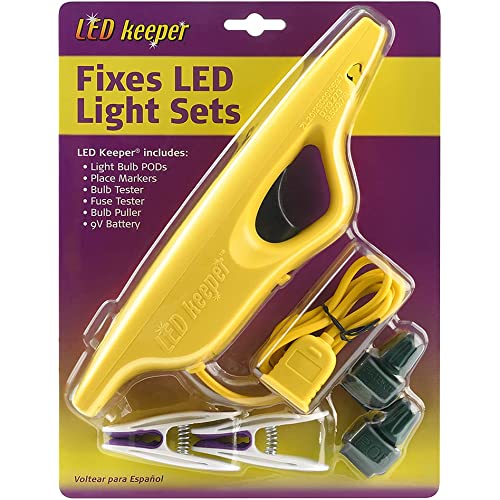

LED Keeper® - LED Holiday Light Set Repair Tool
-

Marcella McDermott I
Greater than one weekI received this yesterday. After reviewing the instructions I was able to repair a strand of lights within 20-25 minutes. The repair of next 5 strands went much quicker. Well worth the money to salvage lights, otherwise theyd of went in the trash.
-

snjguy
> 3 dayGreat little device to save time and money instead of buying lights every year when a half of the string dies and you cant figure out which bulb is bad. There is a learning curve if you follow the instructions. But once you get the hang of it you can go through a string of bulbs in a matter of minutes and find your bad one. Brought back to life six strings of lights that I knew were bad. It has the function to test the lightbulb, fuse and the string of wires. Good investment instead of having to run out and replace your lights.
-

Frank Rogers
> 3 dayJust repaired 8 strings of GE lights that I thought were goners. Some strings had a bad section, some strings only had a short good section. Looked like a nightmare, but wifey said, Lets at least try that tool. Fair enough. Plug a set into an outlet. Mark the start point and end point of the section that wont light. Unplug from wall and plug into the tool. Now, lets say you identified a dark section of 30 lights. Go to the 15th light and squeeze the tester on the wire to that light. In most cases, either lights 1-15 will light, or lights 16 through 30 will light. Lets say lights 1-15 light up. Excellent. Now you KNOW that your naughty LED is hiding among lights 16-30. Time to test again. Where? Split the difference: which in this hypothetical scenario would be around light 23. Squeeze the tester on the wire going into light 23 and... the lights before it or the lights after it will light up! Aha. So your naughty light is hiding among the dark lights... and all you need to do is keep narrowing it down until you hit it. Sometimes you find it quickly, sometimes it takes a little longer. Some of the strings I fixed had 4 or 5 bad lights - which meant doing this process several times, each time on a different section. But I look at it this way: $30 for a tool that just saved me 8x$20=$160 worth of lights. NOTE!! What does a GOOD light look like vs a BAD light? The bad bulb often (not always) has a bad wire on it. To help give you and idea what I mean, take a look at the pictures: One of the wires has burned off of the bad LED. Compare that to the good LED in the other picture: two wires, both intact. Every once in a while (1 out of 15 in my case) you will find a bad LED that looks perfectly good. Fortunately, the tool has a little socket on it so you can test good looking bulbs.
-

Char Star
> 3 dayMakes finding the problem spot so much easier.
-

Benjamin W.
> 3 dayI gave it 4 stars for value for money. However, as far as I know, theres nothing else out there, and this tool is allowing me to repair existing sets. The other problem I have is that I still have a lot of incandescent sets, and I have to spend the money all over again to do my incandescent sets ... (incandescent tester is a little less expensive, but still a little pricey). Maybe Ill breakdown and buy the incandescent tester next year.
-

SweetStephy1
> 3 daySee,title
-

Arlan D. Leeds
> 3 dayI had one fairly long LED icicle string that had a 4ft section go dark last year. When I started putting up my lights this year, that section was still out. I decided to try this tester and within about 5 minutes I had isolated the problem down to a single LED. I replaced the LED and the section came back to life. It definitely saved me from having to buy a new string. I would prefer a pistol grip for holding it and squeezing the trigger... I felt holding this in my hand somewhat awkward. I will add that I am an Engineer who spent most of my career fixing computers, so the logical process of elimination required to use this was very intuitive for me. You have to keep track of what works and what doesnt while youre testing so you can gradually narrow it down to the failed LED(s)/socket(s). For me, it was absolutely worth the money.
-

Psyphyr
> 3 dayDH just saved 3 sets of LED net lights that had lost a section of lights. Theres more trial & error than in tracking down the bad bulb in a string, as the lights in the nets were arranged with a logic that escaped us. We dealt with it by grabbing a silver metallic sharpie to mark the good lights as we went along. When you think youve identified the culprit, be sure to check both wires coming in/out of that light -- if it doesnt light up with either one, thats your bad boy. The remover tool at the end of this tool works great! But it could use some assist to hold the handles closed on the wire while you poke around, especially when working with net lights (like the doohicky that clicks into place to hold the nozzle of my garden hose in the on position. Squeezing the handles of the device so it pierces the wire takes a good bit of hand strength. The price seems high for what it is, but it quickly paid for itself -- Im pretty sure theres no other way we could have identified the bad bulbs and saved these net lights, and replacements arent cheap.
-

Dude from LA
> 3 dayGot an LED string of lights or icicle lights that decided to quit on you? This tool is great! Do go online and watch the repair videos as the instructions are not great. Once you learn how LED lights work and what makes them go bad, this tool shows you exactly how to diagnose and repair a dead portion of a string or a whole string. Well worth the price as lights are bloody expensive.
-

scott
> 3 dayI had 3 GE 150 light strings with varying number of dead sections. One entire string was completely dead. Replaced 4-6 lamps per string. They all now work like new! It would be impossible to have fixed these 3 strings without this tool. It has not only the wire string tester, but LED and fuse testers. I used them all. New lights $60-80, this tool $25. A bargain.
